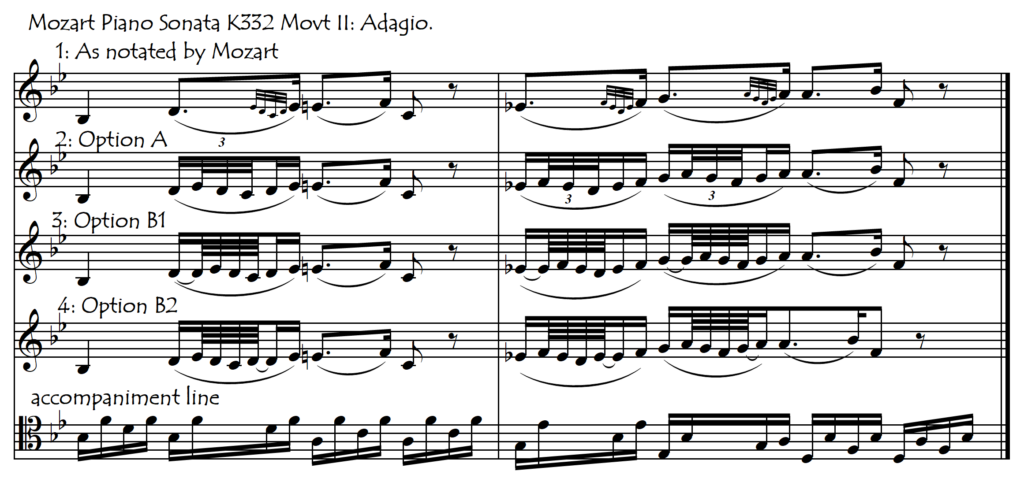Mozart On The Cello
“his music is so perfect, so effortless, that it seems to have been plucked ready-made from the universe”
(Albert Einstein)
Mozart (1756-1791) must have been very unimpressed with the cello and cellists of his epoch. How else could we explain that despite his 23 piano concertos, 5 violin concertos (more or less), a double concerto for violin and viola (Sinfonia Concertante), concertos for oboe, bassoon, clarinet, flute (2), horn (4) and about 20 “mature” violin sonatas, he wrote nothing for the cello as the “solo” instrument ! The closest he came, apart from in his Divertimento for string trio K563, was in his three last string quartets (K575, 589 and 590). These so-called “Prussian” string quartets all have prominent cello parts, in deference to the King of Prussia who was an amateur cellist and to whom they were originally intended.
To remedy this situation, here is a selection of some of Mozart’s cosmic gems, stolen and transcribed for the cello as the principal melodic instrument. Apart from 17 of his Violin Sonatas, you will also find transcriptions of six of his keyboard sonatas. There is no reason why we couldn’t play each movement of any of these sonatas as stand-alone concert pieces. His Clarinet Concerto and a selection of his vocal music is also offered.
These adaptations for cello are definitely “transcriptions” rather than “arrangements” in the sense that the music is (almost) never rewritten in any way other than some key transpositions (always applied to entire works), octave changes of entire passages, or the revoicing of chords and double stops.
*****************************
TRILLS, ORNAMENTS, AND GRACE NOTES
Mozart’s music, in true Rococo style, is full of ornamentation and grace notes, however it is only in the “Literal Versions” that these grace notes and ornaments are always notated exactly as Mozart wrote them. In the “playing” versions (Edited, Easier and Clean), they are often written as played by the editor. There are several reasons for this:
- trills on very short notes have often been substituted for mordents or turns, to compensate for the difference in size and reaction time between violin and cello: the cello is just not as quick and agile as the violin …….. we wouldn’t expect a french horn to play like a saxophone, or a double bass like a cello!
- the original notation of many grace notes is often quite ambiguous with respect to how exactly we might want to play these notes (their exact position rhythmically). Those same little grace notes, always notated before the principal note, can be played either before or on the beat. They can also be played in a variety of lengths anywhere between very short and very long. The following examples illustrate some of these possibilities:

This ambiguity can be a delight, but it can also be a source of confusion. Therefore, for the sake of simplicity and clarity, in the playing versions of these Sonatas, those grace notes that are not played before the beat have been notated as “real” notes.
Turns also give us many possibilities for where exactly we might want to place the notes. For slower turns it can help to use a quintuplet to avoid making our ornament sound laboured, pedantic and mathematical. For rapid, sparkling, virtuosic turns the quintuplet is probably not necessary:

Even if we decide to make a quintuplet turn, we can still sometimes have some doubts about where exactly to put the quintuplet notes. Independently of whether we use quintuplets or not, the multiple possibilities for the rhythmical placement of the notes in turns can cause headaches for both interpreters and editors:

The editing (writing out with an exact notation) of the ornaments and grace notes is not perhaps the ideal solution as it imposes definitively the editor’s decisions on the player. Probably it would be better for the “Clean Version” to have always the original notation of ornaments and grace notes, but the “Clean” version is always composed of the identical notes and rhythms as the “Edited” version, with all other editorial suggestions removed. Unfortunately, because grace notes and ornaments are “notes and rhythm”, the decisions made for the “Edited Concert Versions” also apply to the “Clean Versions”. Therefore, only in the “Literal Versions” are the grace notes shown as Mozart notated them.
*******************************
Mozart was not very trusting of his contemporary cellists’ abilities so he rarely took the cello into its higher register. But it does happen occasionally and here below are links to compilations of passages from his original music for cello, in which the use of Thumbposition and the Intermediate Region of the fingerboard is either essential, advisable or possible:
